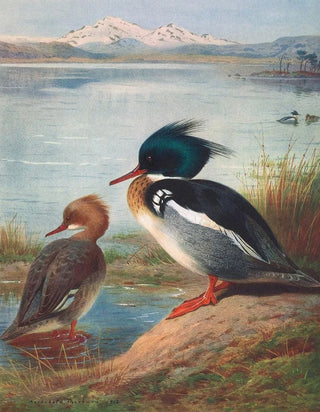Art print | Harle huppé - Archibald Thorburn


View from behind

Frame (optional)
In the fascinating world of ornithological art, the "Harle huppé" by Archibald Thorburn stands out for its elegance and depth. This painting, which captures the rare beauty of this aquatic bird, immerses us in a world where nature is celebrated with almost photographic precision. Thorburn, a true virtuoso, manages to immortalize the fleeting moment of a encounter with this majestic bird, inviting the viewer to appreciate the delicacy of each feather, the nuance of colors, and the grace of movements. The art print of this work not only allows for an appreciation of the artist's technique but also awakens in us a curiosity for the fauna that surrounds us.
Style and uniqueness of the work
Archibald Thorburn's style is characterized by meticulous realism and particular attention to detail. In "Harle huppé," every element is carefully studied, from reflections on the water to shadows cast by the bird. The color palette chosen by the artist evokes the richness of natural environments, oscillating between vivid hues and softer shades. This contrast creates an atmosphere that is both lively and soothing, transporting the viewer to a landscape where the beauty of nature is omnipresent. The posture of the harle, both majestic and delicate, demonstrates Thorburn's skill in capturing the very essence of his subjects. Thus, each glance at this art print becomes an invitation to contemplate the splendor of the animal world.
The artist and his influence
Archibald Thorburn, born in 1860, is recognized as one of the greatest naturalist artists of his time. His passion for birds and nature manifested from a young age, profoundly influencing his artistic journey. Through his works, he not only immortalized fauna but also raised public awareness about conservation. His unique approach, blending art and science, inspired many artists and naturalists. Thorburn was able to translate his love for birds into a series of paintings that testify to his technical mastery and his commitment to nature. His influence endures

Matte finish

View from behind

Frame (optional)
In the fascinating world of ornithological art, the "Harle huppé" by Archibald Thorburn stands out for its elegance and depth. This painting, which captures the rare beauty of this aquatic bird, immerses us in a world where nature is celebrated with almost photographic precision. Thorburn, a true virtuoso, manages to immortalize the fleeting moment of a encounter with this majestic bird, inviting the viewer to appreciate the delicacy of each feather, the nuance of colors, and the grace of movements. The art print of this work not only allows for an appreciation of the artist's technique but also awakens in us a curiosity for the fauna that surrounds us.
Style and uniqueness of the work
Archibald Thorburn's style is characterized by meticulous realism and particular attention to detail. In "Harle huppé," every element is carefully studied, from reflections on the water to shadows cast by the bird. The color palette chosen by the artist evokes the richness of natural environments, oscillating between vivid hues and softer shades. This contrast creates an atmosphere that is both lively and soothing, transporting the viewer to a landscape where the beauty of nature is omnipresent. The posture of the harle, both majestic and delicate, demonstrates Thorburn's skill in capturing the very essence of his subjects. Thus, each glance at this art print becomes an invitation to contemplate the splendor of the animal world.
The artist and his influence
Archibald Thorburn, born in 1860, is recognized as one of the greatest naturalist artists of his time. His passion for birds and nature manifested from a young age, profoundly influencing his artistic journey. Through his works, he not only immortalized fauna but also raised public awareness about conservation. His unique approach, blending art and science, inspired many artists and naturalists. Thorburn was able to translate his love for birds into a series of paintings that testify to his technical mastery and his commitment to nature. His influence endures






